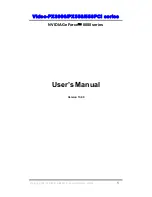
FastTrak TX2000™ Series User Manual
52
Cannot Rebuild Mirrored (RAID 1) Array
(see “Unable to Partition or Format array” above)
Fatal Errors or Data Corruption Are Constantly Reported When Reading or Writing to
Drive Array
(see “Unable to Partition or Format array” above)
Operating System-Related Issues
Different drive lettering under Windows NT
This may happen when using a SCSI card in addition to the Promise card. Windows NT does
not necessarily load the driver for the boot device controller first. This results in a drive that in
MS-DOS is the C: drive being the D:, or E:, etc. in Windows NT. Use Windows NT’s Disk
Administrator utility to reassign the letters that NT has assigned to the drives. See your
Windows NT documentation for instructions on how to use Disk Administrator.
The Operating System no longer boots after creating a Mirrored Array using your
existing boot drive using Windows 98/NT4/2000/XP
This is due to Drive Geometry issues. You can verify this if you move the original drive back to
the onboard controller and it boots. Each controller can view a drive differently. This can be an
issue for a new controller that loads the original Master Boot Record (MBR) and then has a
problem translating it or the Operating System boot record.
For Windows NT, Windows 2000, and Windows XP Promise recommends a “clean” install of
the Operating System. This restores the MBR and OS boot record. This requires repartitioning
and formatting the drive.
For Windows 98,you can perform the DOS Command “SYS C:” from a bootable floppy or CD-
ROM to restore the operating system boot record and transfer the system files to the boot drive.
If this does not work, the Windows 98 registry may have become corrupted during the boot
process and must be restored. See the Windows documentation to perform this procedure.
Promise Windows driver does not appear in Device Manager
Windows may already be listing the controller under “Other Devices” instead of “Hard disk
controllers” section. In Device Manager under “Other Devices” to see if it lists a “PCI Card”, or
“RAID Controller”. If so, highlight this listing and click on the “Properties” button, and then click
on the “Driver” tab. Depending on your version of Windows, choose either “Change Driver” or
“Update Driver”. Then follow the on-screen prompts to complete installation of the driver. If
Windows asks if you want to test if the device can be removed safely click on “CANCEL.
Reboot the system to complete installation of the driver.
“Inaccessible Boot Device” Message Appears During Floppyless Install of Windows NT,
2000, or XP
The "F6" key was not pressed at the appropriate time. Reboot the system, and press the "F6"
key when the message "Setup is inspecting your computer's hardware configuration…" appears
in Windows NT4 or the message "Press F6 if you need to install third party SCSI or RAID
driver" appears in Windows 2000.















































